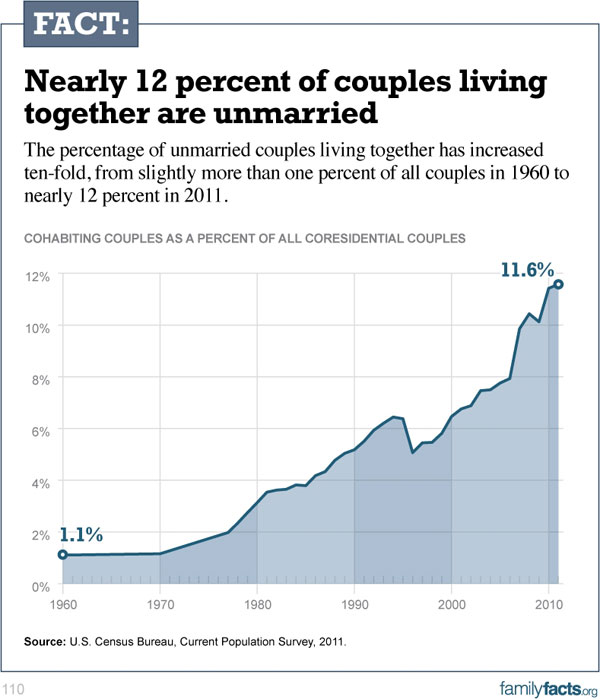The percentage of babies born to cohabiting women has jumped substantially in the last 10 years, according to new data from the National Center for Health Statistics.
“The number of births overall to cohabiting women increased from 14% of all births in 2002 to 23% in 2006-10,” reports USA Today.
As marriage rates have been steadily on the decline in the last six decades, cohabitation rates have been ticking upward. Along with higher rates of cohabitation, not surprisingly, is an increase in births to these couples. Of the over 40 percent of unwed births today, roughly half are to cohabiting women. (continued below chart)
According to Professor Brad Wilcox, director of the National Marriage Project, “the rise of cohabiting households with children is the largest unrecognized threat to the quality and stability of children’s family lives.” As he notes in his report Why Marriage Matters: Thirty Conclusions from the Social Sciences, in the last half of the 20th century, “divorce was the event most likely to undercut the quality and stability of children’s family lives.” However, today children are more likely to spend time in a cohabiting household than to see their parents divorce.
Much of the risk for children in cohabitation stems from the high rate of instability among these couples. A 2007 study shows that roughly two-thirds of unmarried parents separate within five years after having a child, and only about one in five of these couples end up getting married within that timeframe. In contrast, more than 80 percent of married couples will still be together within five years of their children’s births.
Children in cohabiting families also do not reap the same benefits as their peers born to married parents. On average, these children fail to perform as well academically, exhibit more behavioral problems, have poorer health, are at greater risk for abuse, and are more likely to be sexually active as teens. They don’t fare much better financially than children in single-parent homes either, meaning they are far more likely to be poor.
Tragically, cohabitation and particularly unwed births occur more often among low- and moderately educated Americans. The poorer outcomes for children born outside of marriage, including higher poverty, mean that these children and their families, already with limited resources, are now doubly disadvantaged compared to their more highly educated peers who overwhelmingly wait until marriage to have children. This trend is creating a “two-caste society” divided along the lines of marriage and education.
As Wilcox points out, “The intact, biological, married family remains the Gold Standard for family life in the United States. Children are most likely to thrive, economically, socially, and psychologically, in this family form.”
Marriage benefits society as a whole, producing individuals who are more likely to thrive. Higher rates of cohabitation and fewer marriages mean that more children will fail to reap the benefits this institution provides.
It is crucial that policymakers look for ways to strengthen marriages in their communities, particularly in lower- and working-class communities, in order to ensure the best outcomes for children and for all of society.

























